高中英语 Unit2教学反思人教版必修五
高中英语_Book5 Unit2 Puzzles in Geography教学设计学情分析教材分析课后反思
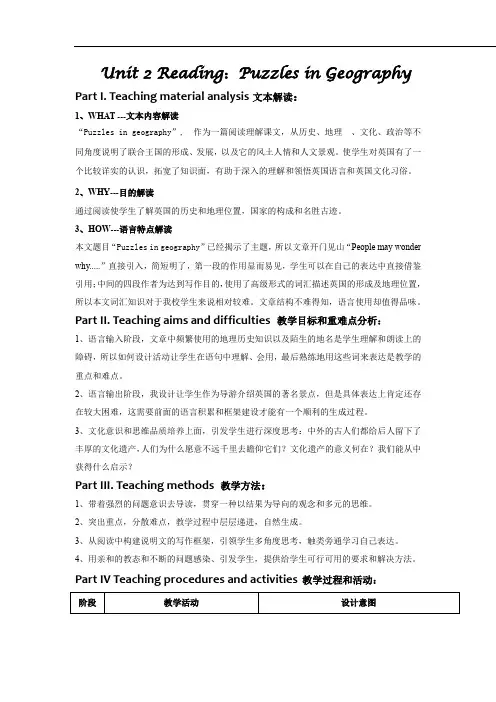
Unit 2 Reading:Puzzles in Geography Part I. Teaching material analysis文本解读:1、WHAT ---文本内容解读“Puzzles in geography”, 作为一篇阅读理解课文,从历史、地理、文化、政治等不同角度说明了联合王国的形成、发展,以及它的风土人情和人文景观。
使学生对英国有了一个比较详实的认识,拓宽了知识面,有助于深入的理解和领悟英国语言和英国文化习俗。
2、WHY---目的解读通过阅读使学生了解英国的历史和地理位置,国家的构成和名胜古迹。
3、HOW---语言特点解读本文题目“Puzzles in geography”已经揭示了主题,所以文章开门见山“People may wonder why.....”直接引入,简短明了,第一段的作用显而易见,学生可以在自己的表达中直接借鉴引用;中间的四段作者为达到写作目的,使用了高级形式的词汇描述英国的形成及地理位置,所以本文词汇知识对于我校学生来说相对较难。
文章结构不难得知,语言使用却值得品味。
Part II. Teaching aims and difficulties 教学目标和重难点分析:1、语言输入阶段,文章中频繁使用的地理历史知识以及陌生的地名是学生理解和朗读上的障碍,所以如何设计活动让学生在语句中理解、会用,最后熟练地用这些词来表达是教学的重点和难点。
2、语言输出阶段,我设计让学生作为导游介绍英国的著名景点,但是具体表达上肯定还存在较大困难,这需要前面的语言积累和框架建设才能有一个顺利的生成过程。
3、文化意识和思维品质培养上面,引发学生进行深度思考:中外的古人们都给后人留下了丰厚的文化遗产,人们为什么愿意不远千里去瞻仰它们?文化遗产的意义何在?我们能从中获得什么启示?Part III. Teaching methods 教学方法:1、带着强烈的问题意识去导读,贯穿一种以结果为导向的观念和多元的思维。
module 5 unit 2教学反思
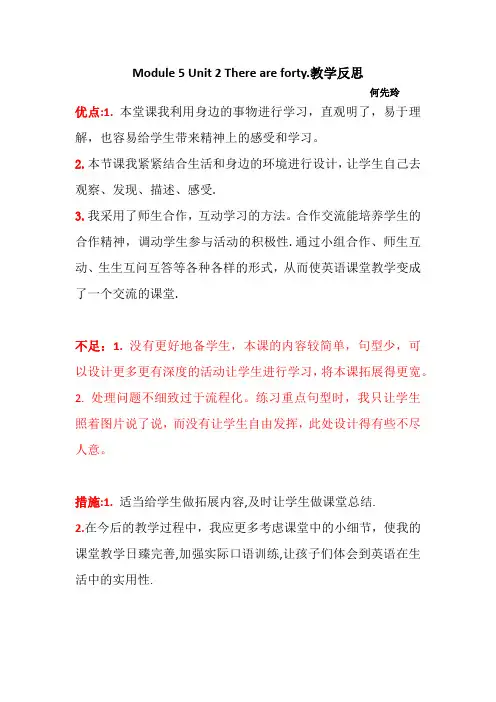
Module 5 Unit 2 There are forty.教学反思
何先玲
优点:1.本堂课我利用身边的事物进行学习,直观明了,易于理解,也容易给学生带来精神上的感受和学习。
2.本节课我紧紧结合生活和身边的环境进行设计,让学生自己去观察、发现、描述、感受.
3.我采用了师生合作,互动学习的方法。
合作交流能培养学生的合作精神,调动学生参与活动的积极性.通过小组合作、师生互动、生生互问互答等各种各样的形式,从而使英语课堂教学变成了一个交流的课堂.
不足:1.没有更好地备学生,本课的内容较简单,句型少,可以设计更多更有深度的活动让学生进行学习,将本课拓展得更宽。
2. 处理问题不细致过于流程化。
练习重点句型时,我只让学生照着图片说了说,而没有让学生自由发挥,此处设计得有些不尽人意。
措施:1.适当给学生做拓展内容,及时让学生做课堂总结.
2.在今后的教学过程中,我应更多考虑课堂中的小细节,使我的课堂教学日臻完善,加强实际口语训练,让孩子们体会到英语在生活中的实用性.。
5A Unit2 A new student(story time)教学反思
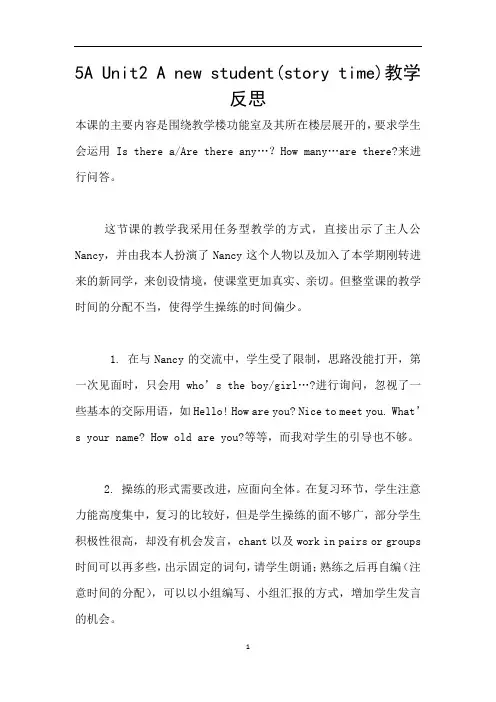
5A Unit2 A new student(story time)教学反思本课的主要内容是围绕教学楼功能室及其所在楼层展开的,要求学生会运用 Is there a/Are there any…?How many…are there?来进行问答。
这节课的教学我采用任务型教学的方式,直接出示了主人公Nancy,并由我本人扮演了Nancy这个人物以及加入了本学期刚转进来的新同学,来创设情境,使课堂更加真实、亲切。
但整堂课的教学时间的分配不当,使得学生操练的时间偏少。
1. 在与Nancy的交流中,学生受了限制,思路没能打开,第一次见面时,只会用who’s the boy/girl…?进行询问,忽视了一些基本的交际用语,如Hello! How are you? Nice to meet you. What’s your name? How old are you?等等,而我对学生的引导也不够。
2. 操练的形式需要改进,应面向全体。
在复习环节,学生注意力能高度集中,复习的比较好,但是学生操练的面不够广,部分学生积极性很高,却没有机会发言,chant以及work in pairs or groups 时间可以再多些,出示固定的词句,请学生朗诵;熟练之后再自编(注意时间的分配),可以以小组编写、小组汇报的方式,增加学生发言的机会。
3. 灵活反应能力不强,缺少教学智慧。
新授环节,我先考查了学生与陌生人打招呼和自我介绍的能力。
学生一开始的积极性比较高,但是很快就遇到了瓶颈,有的学生想说的内容,其他同学说过了,便失去了兴趣,积极性很快就降低了。
但有的同学说得很好,回忆起了there is/ are...in our school; this is...room等上一单元或之前学过的句型。
因此老师要善于引导学生回忆旧知,应用新学的知识,当学生遇到瓶颈时,教师要及时给予引导,保持和激发学生的会话的热情。
4. 梳理脉络,熟练背诵。
高二必修五《Unit2 The United Kingdom》课后反思
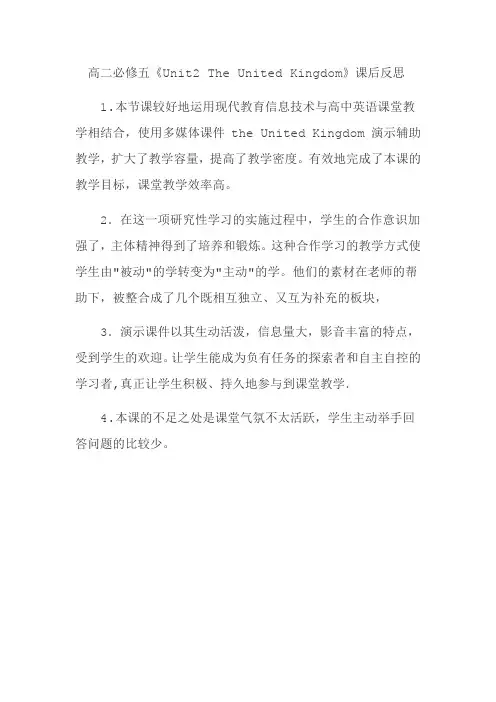
高二必修五《Unit2 The United Kingdom》课后反思
1.本节课较好地运用现代教育信息技术与高中英语课堂教学相结合,使用多媒体课件 the United Kingdom 演示辅助教学,扩大了教学容量,提高了教学密度。
有效地完成了本课的教学目标,课堂教学效率高。
2.在这一项研究性学习的实施过程中,学生的合作意识加强了,主体精神得到了培养和锻炼。
这种合作学习的教学方式使学生由"被动"的学转变为"主动"的学。
他们的素材在老师的帮助下,被整合成了几个既相互独立、又互为补充的板块,3.演示课件以其生动活泼,信息量大,影音丰富的特点,受到学生的欢迎。
让学生能成为负有任务的探索者和自主自控的学习者,真正让学生积极、持久地参与到课堂教学.
4.本课的不足之处是课堂气氛不太活跃,学生主动举手回答问题的比较少。
英语Unit2教学反思
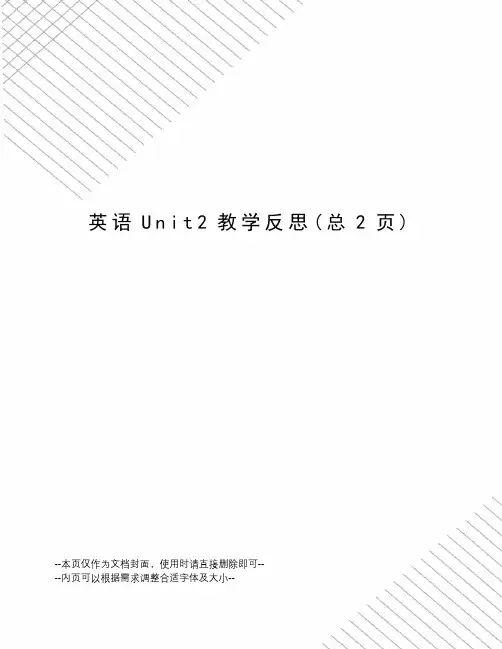
英语U n i t2教学反思(总2页)--本页仅作为文档封面,使用时请直接删除即可----内页可以根据需求调整合适字体及大小--英语Unit2教学反思英语Unit2教学反思本单元中,我注重从学生的实际出发,挖掘生活中素材,从激发学生的学习兴趣入手,尽可能地让课堂贴近生活。
在热身复习部分,我充分发挥英语歌曲在英语教学中的作用,因为唱一唱不仅给学生营造英语学习氛围,激活学生的英语思维,把学生的注意力引到英语课中来,而且为学习新知识埋下了伏笔,为上好一堂课做了良好的前奏。
新知呈现中,我把握住新、旧知识的联系,化难为易,在感性的操练中理解、运用人称代词和句型。
围绕本节课的语言知识的学习与语言技能的训练,我设计了活泼多样的教学活动代替机械操练,调动学生多种感官参与教学。
如:1.学生朗读Les’stalk后,我将图片打乱顺序,播放录音。
学生比赛谁最快指出相应的图,并大声朗读出来。
2.我拿出几张全家福,抽出其中一张,问:Whosefamilyisthis?引导该家庭的学生迅速反应:Thisismyfamily.然后指着照片中的人物发问,给予回答流利的学生奖励,并不时用“Good!Great!”拿语言鼓励。
3、两人一组,谈论各自的照片,操练Let’spractise的内容。
在活动的设计上,我非常注意到渐进性,即由易到难的学习顺序。
本节课我采用了学生喜欢的猜猜游戏,这个活动有效的激活了学生已有的知识,激发了学生学习的内在动力,不仅让学生带着浓厚的兴趣学下去,最主要的是培养了学生的'发散思维能力。
在活动方式上我还采用了小组合作,培养学生的自主性、合作意识以及分析处理问题的能力,并将评价带入课堂,让学生真正成为评价的主体。
因为学生在平时的英语教学中已经学过Thisis…(名字).等句子,因此我没有把教学内容只局限于此,而是拓展了教学的思路,创造情景,帮助学生尽可能地2扩大语言的输出。
最后我在作业的布置上给学生一个任务,即各自拿着自己的全家福互问互答。
高中英语_必修5 Unit2 The United Kingdom教学设计学情分析教材分析课后反思
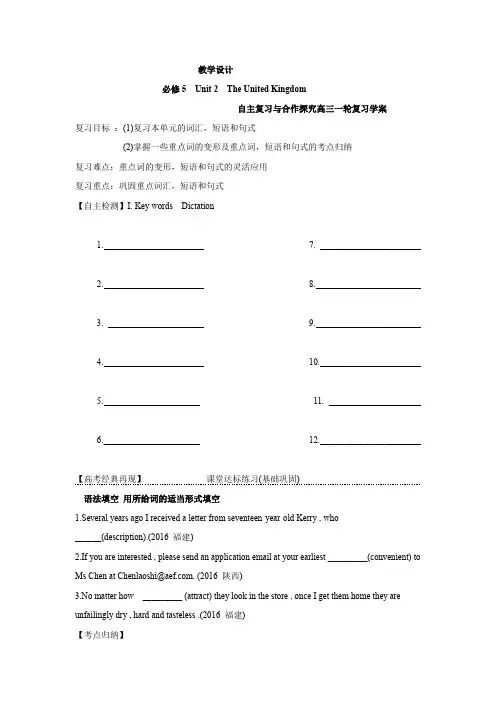
教学设计必修5 Unit 2 The United Kingdom自主复习与合作探究高三一轮复习学案复习目标:(1)复习本单元的词汇,短语和句式(2)掌握一些重点词的变形及重点词,短语和句式的考点归纳复习难点:重点词的变形,短语和句式的灵活应用复习重点:巩固重点词汇,短语和句式【自主检测】I. Key words Dictation1. 7. _____________2. 8. ______________3. 9. _____________4. 10. _____________5. 11. ______________6._ 12._______________【高考经典再现】课堂达标练习(基础巩固)语法填空用所给词的适当形式填空1.Several years ago I received a letter from seventeen-year-old Kerry , who______(description).(2016 福建)2.If you are interested , please send an application email at your earliest _________(convenient) to Ms Chen at Chenlaoshi@. (2016 陕西)3.No matter how _________ (attract) they look in the store , once I get them home they are unfailingly dry , hard and tasteless .(2016 福建)【考点归纳】attract one’s attention _____ attract sb. to sth _____, be attracted by _____4. Listening is thus an active , not a passive , behavior ___________(consist) of hearing , understanding and remembering (2016 浙江)【考点归纳】consist of ____consist in_____consist with_____be consistent with_____(2016天津高考)单句语法填空①Students are provided with breakfast , dinner and either a cooked or packed lunch which consists ____ a sandwich , a drink and a dessert .②Success consists _____ the ability to continue efforts .5.In the eight-mile journey , I crossed the same railroad track five times , giving the___________(possible) of getting caught by the same train five times . (2015 湖南)6. The Jibo robot, ________(arrange) to ship later this year , is designed to be a personalized assistant .(2015 天津)【考点归纳】arrange to do ____, arrange for sb. to do _____, arrange sth for sb ____(2016全国卷I)单句语法填空She arranged _____ a flight on a small plane to be held for me,re-routed (改道) me through Newark and got me back to theUK even earlier than originally scheduled .7.The three countries found themselves _________ (unite) peacefully instead of by car (2015 四川)8. The professor was _________(delight) to find that two thirds of the project had been finished by the students independently (2015 湖北高考)【考点归纳】be delighted to do /in doing sth _____be delighted at /by ____to one's delight _____【自主检测】II. Key phrases1. 由---组成 6.take the place of _____________2. 把---分成--7.for convenience _____________3. 挣脱,脱离8.leave for4. 为纪念9.to one’s credit _5. 省去,遗漏10. break down _____________【短语填空和单句改错】课堂达标练习用以上适当的短语填空1.The circle ___________ sections , and each section represents a fraction (小部分)of the data(2015 浙江) doesn’t __________ reading for most children ; (2015 广东)3.Then he said they had found a pile of papers in their trash can that ______________on the footpath (人行道)(2015 新课标全国II)【考点归纳】leave out ___leave for ____leave alone _____leave aside ____leave off______(2016 湖南高考)单句语法填空Applying my own rule , I determined to write them in alphabetical order (按字母顺序), never letting myself leave ______ a tough idea .4.He _________as he thought his failure to sell all his papers . (2015 湖北高考单句改错5.For her credit , Emma passed such a difficult examination .(2016 昆明高三联考)6.Under no condition will the Chinese allow Taiwan to break away China .【考点归纳】break out ___ , break in ____. break off , _____break up ____7.It seems strange that the town should be named after Mr. Smith , in the memory of his greatcontributions to its development .III. 重点句型I.It seemed strange that the man who had developed communism should have lived and died in London.【合作探究】在It be/seems + strange / important/necessary/natural /a pity/a shame ---that ----句型中,(1)It作,that引导的是从句,从句中常使用语气,形式为,可以省略,强调过去的情况时可用+ have done .(2)should 在此句型中表示“理应如此,惊讶,怀疑,惋惜”意为“应该,竟然”(3)翻译句子:___________________________________________________________【达标专练】(1)完成句子It is true that we may suffer from failure from time to time . However , __________________lose the enthusiasm to keep on trying .(2015 福建高考写作)我们会应不时的失败而痛苦这是事实,但是重要的是我们不应该失去继续尝试的热情。
高中英语_人教版必修5Unit2 The United Kingdom教学设计学情分析教材分析课后反思
教学设计面向学生:高中学科:English课时:1学生课前准备:1) 读熟本单元单词。
2) 完成课前准备的学习学案中预习部分。
3) 准备作文纸,红色笔以及词典等写作需要的物品。
教学课题Reading part: Puzzles in geographyLearning goals 学习目标1.知识与能力:to understand the main idea of the passage and learn more about theUnited Kingdom2.过程与方法:To improve students’reading abilities, such as skimming, scanningand careful reading3.情感态度价值观: To arouse students’great interest to the foreign cultures.教材分析本单元是必修五的第二单元,以The United Kingdom 为中心话题。
通过学习,使学生了解英国的历史、地理、政治、文化、宗教、社会习俗以及名胜古迹等有关知识。
旨在通过本单元的学习使学生加强对英国的了解,从而使学生更深入地理解和领悟英语。
文章体裁是说明文,Reading中以标题PUZZLES IN GEOGRAPHY引起学生的好奇心,使学生迫不及待地阅读这篇文章。
在阅读过程中,教师可充分利用多媒体生动形象地展示英国的发展过程.教学过程Step 1 Fast ReadingTask 1.What does the passage mainly tell us?Step 2 Careful Reading:Read each paragraph and finish the following questions.Para 11.Which words or phrases are consistent with the word “puzzles”?2. How can you get rid of the puzzles?Para2.1. How is this paragraph organized?2. How was this done?3. How does the author feel about “this”?Para31. In which areas do the four countries work together?2. How does the writer feel about the four countries working together in some areas ?3. What information can you get from “in some areas ”in the first line and “but” in the second line?Para41.England can be divided into_____ zones. They are:___________ ______________ ____________ .2. What is the feature(特征) of each zone?3. Which word or phrase shows the attitude of the author towards the industrial cities?4. Where can you find more about British history and culture?Para5.1.Why does London become the cultural center of England?2. What are the historical treasures?DiscussionWhy is Lndon the capital of England, Great Britain and the UK?Para 6. What is the author’s purpose of writin g the reading passage?Step3 Post readingThe full name of the UK is the ______ _________ of______________and_______ ________. It consists of four parts, they are________, _________, ______ and ________________. People alwaysthink ______ is a part of England. The flag of the UK is called the___________.The four countries have different __________ and _____ _______ aswell as different _______ ______. ________ is the largest of the fourcountries and it is ______ ____ three parts. Most of the people settled inthe ______, but most of the large industrial cities in the _________ andthe ______. The capital of the UK is _______, which has many greatplaces of interest.HomeworkWrite a short passage about how the UK came into being教学反思:本课时是本单元的阅读课时,让学生从地理、历史、政治、文化等多角度了解英国的形成、发展以及它的风土人情和人文景观,使学生对英国有一个比较详实的认识。
高中英语必修Unit 2 Olympic Games教学反思
高中英语必修Unit 2 Olympic Games教学反思教学反思:高中英语必修Unit 2 Olympic Games在本次教学中,我担任高中英语必修Unit 2 Olympic Games的教师,通过对本单元内容的教学,我对教学效果和自身教学方法进行了反思。
在这篇文章中,我将分享我在教学过程中的经验和教训,以及我对于教学改进的建议。
首先,本单元主要内容是关于奥运会的介绍和相关英语表达。
我在课堂上采用了多种教学方法,如课堂讨论、小组合作、角色扮演等,以激发学生的兴趣和参与度。
我将学生分成小组,并给予他们提前分配好的相关话题,鼓励他们在小组内展开讨论并展示他们的集体成果。
这种方式不仅提高了学生在英语表达方面的能力,还培养了他们的合作精神和团队意识。
然而,我也发现了一些不足之处。
首先,在开展课堂讨论时,有些学生缺乏主动参与的意愿。
这可能是因为他们对英语表达还不够自信,或者他们害怕犯错误。
为了解决这个问题,我打算在今后的教学中,设计更多的互动活动,以提高学生的口语表达能力,并鼓励他们敢于发言。
其次,我发现在角色扮演环节,有些学生只是机械地重复对话内容,而没有理解其中的意义和背后所蕴含的文化。
因此,在今后的教学中,我将加强对话内容的解释和分析,让学生更好地理解英语与文化的关系。
除此之外,我还希望在教学过程中注重学生的学习兴趣和动机。
我发现,有些学生对于奥运会的相关知识缺乏兴趣,导致他们在学习中缺乏积极性。
为了解决这个问题,我计划在教学中引入一些互动游戏和多媒体资源,以增加教学内容的吸引力,并激发学生的学习兴趣。
此外,我也意识到需要更多地关注学生的个性化学习需求。
每个学生都有不同的学习方式和学习节奏,我需要更多地与学生沟通,了解他们的学习需求,并根据他们的实际情况进行个性化辅导。
我计划在今后的教学中,通过定期小测验和个人反馈,了解学生的学习进展,并给予他们更具针对性的指导。
综上所述,本次高中英语必修Unit 2 Olympic Games的教学反思中,我认识到自己在教学中的不足之处,并提出了相应的改进措施。
2021年高中英语必修2教学反思
高中英语必修2教学反思高中英语是学生考上好大学的关键因素。
为大家收集的教学反思,希望大家都喜欢。
引言高一新生正处于心理和生理的迅速发展阶段,这是他们成长过程中的一个特定时期。
他们渴望 ___,却又有较重的依赖心理; 他们精力旺盛,而能力水平又较低; 他们有一定的自觉性,却易冲动,易受暗示,表现出较差的自制力。
由于生理发展迅速而自我意识发展不平衡,容易动感情,常常为一些小事而激动,行为带有冲动性。
对于高一新生来说,英语的具体困难在于:( 1) 初、高中英语知识目标和能力目标的差异使高中新生对高中英语学习有一种陌生感。
( 2) 汉语言的语法结构规律及表达方式,汉语言的思维方式和思维习惯都对英语学习形成干扰。
( 3) 和思维习惯不同,在新的环境下需要时间来适应而同时发现自己成功的学习方法和思维方式被新的现实所否定,再加上思维定势,在学习过程中,缺乏必需的意志和韧性,对学习丧失信心。
下面是 ___在教学实践中提高高一学生英语学习能力的一些:一、重视过渡,从思想上帮助学生适应变化在初中阶段,英语教学侧重句型教学,讲简单的语法,词汇量要求不多。
高中英语教学则要求学生掌握一定的阅读技能,加强阅读量,同时,语法知识更复杂、更系统,词汇量也大大地增多。
这些变化对于刚踏入高中大门的学生来说,一时是很难适应的。
有些初中时的佼佼者一时适应不过来,成绩下滑,学习兴趣就逐渐减弱。
因此,高一教师一开始就要加大感情投入,给予学生细心的指导,让他们从思想上、心理上接受新的学习节奏。
教师在教学中应善于发现学生的闪光点,给予充分的肯定和鼓励,让他们能尽快摆脱困境,适应并喜欢高中英语,以崭新的面貌,信心十足地投入高中英语的学习中。
高中教材内容丰富,知识容量大,并在初中的基础上注人了大量的语法点、知识点,使句子结构更为复杂,同时侧重提高阅读能力且加大词汇量和阅读材料的份量,加上教师对重难点内容没有更多的时间强调,对各类题型也不可能全面讲细和巩固强化,学生一下子难以适应,教师要特别注意学生这方面的苗头,使学生尽快适应高中英语的教学。
高中英语(人教版)必修二教学反思:Unit5Music(ReadingⅡ)
阅读第二课时,拿到课题时,迷惘是我的情绪写照。
既然是ReadingII自然应该有别于Learning about Language。
只是,哪里不同,如何不同,学生在这节课的学习目标又该如何设定。
只有解决了这些困惑,教学设计的方向和思路才能渐渐清晰。
在参阅了郑老师对于阅读课课时教学目标的分层设定的建议后,对于阅读第二课时我的解读是read be tween lines and read beyond lines。
以下摘自郑老师的《高中英语单元语言教学目标的分解和细化——以人教版高中英语模块6第3单中小学外语教学The Band that Wasn’t,一个省略句的标题的完成能够反映出学生是否深层次理解语篇。
学生在阅读后联系文本内容,分析理解,慢慢品味,才能体会其写作手法的精妙,感受其折射的语言艺术和文化魅力,从中获得阅读美感,提升阅读层次。
为了能够帮助学生更全面体会标题,为学生创建脚手架,是教师真正意义发挥导的作用。
在仔细品读这篇文章之后,对比是作者贯穿始终的写作手法。
门基乐队和一般乐队的对比,门基乐队的前后期的对比这两条主线就构成了The Band that Wasn’t的两个角度的解读。
在理清文章文脉里,复现相关词、句,学会重点词汇attach importance to, be familiar with/to的运用。
所以,我的设计主线确定为通过对比阅读,不同角度解读标题。
Read between lines,引导学生对写作语言的关注和体验也是阅读第二课时的目标之一。
第二段中,earn extra money, be paid in cash, become millionaires集中性关于金钱词汇的运用,和最后一段时间词的运用,以及however, there was one band tha t started in a different way中however这种sign word的运用,希望学生能对这些词汇进行运用。
- 1、下载文档前请自行甄别文档内容的完整性,平台不提供额外的编辑、内容补充、找答案等附加服务。
- 2、"仅部分预览"的文档,不可在线预览部分如存在完整性等问题,可反馈申请退款(可完整预览的文档不适用该条件!)。
- 3、如文档侵犯您的权益,请联系客服反馈,我们会尽快为您处理(人工客服工作时间:9:00-18:30)。
人教课标必修5Unit2 The United Kingdom
【教学反思】
1.研究性学习案例较好地运用现代教育信息技术与高中英语课堂教学相结合,使用多媒体课件 the United Kingdom 演示辅助教学,扩大了教学容量,提高了教学密度。
有效地完成了本课的教学目标,课堂教学效率高。
2.在这一项研究性学习的实施过程中,学生的合作意识加强了,主体精神得到了培养和锻炼。
这种合作学习的教学方式使学生由“被动”的学转变为“主动”的学。
他们的素材在老师的帮助下,被整合成了几个既相互独立、又互为补充的板块,做成演示课件,在多媒体教室里向学生展示,创造了一个在普通教室里,用书本、粉笔、录音机根本无法实现的英语环境,加深了学生对课文的理解和记忆,取得了很好的效果。
另外,这样的课可以使各个学科的相互联系更为紧密。
如进行本课的教学时,还涉及到了地理、历史学科的内容,这样,英语教学就与这些学科内容的教学融为一体了。
3.演示课件以其生动活泼,信息量大,影音丰富的特点,受到教师和学生的欢迎。
让学生能成为负有任务的探索者和自主自控的学习者,真正让学生积极、持久地参与到课堂教学.。
